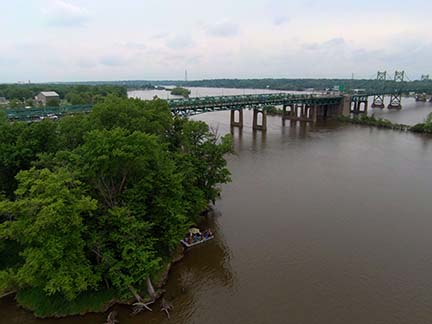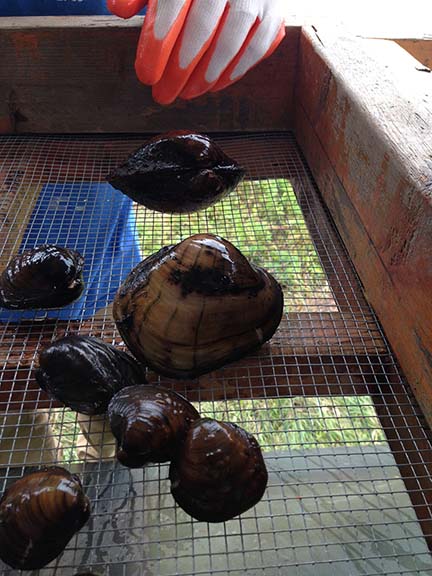A multi-agency effort including the Iowa Department of Transportation successfully relocated tens of thousands of freshwater mussels in the Mississippi River—including three federally endangered species—to protect them from bridge construction in what is possibly the largest single-project mussel relocation in the country.

I-74 Bridge over the Mississippi River. Photo: Iowa DOT
The mussel relocation, part of the project to construct a new bridge to carry I-74 over the river between Moline, Illinois, and Bettendorf, Iowa, was a joint effort of several state and federal agencies that planned and accomplished the task under an unusually tight timeframe, according to Mary Kay Solberg, Environmental Specialist Senior with the Iowa DOT and a key participant in the project.
More than 150,000 mussels were relocated between August and October 2016 to prepare for the start of construction. In doing so, direct impacts to 32 species of mussels, including threatened and endangered species, were minimized or avoided altogether.
“To my knowledge, that was the largest single-project relocation in the U.S.,” Solberg said. Mussels play an important role in the ecosystem because they filter the water and help to improve water quality.
Project Background
The I-74 bridge project has been in development for about 20 years, according to Solberg. The current two spans for I-74 were built in 1935 and 1959.
When the environmental impact statement and record of decision were completed, the numbers and diversity of mussels were unclear. Native mussel populations were presumed to be minimal in the project area due to the presence of invasive zebra mussels, which can outcompete native species. Also, the selected bridge alignment was expected to avoid impacts to what was at the time the only mussel listed under the Endangered Species Act inhabiting the project area, the Higgins eye pearly mussel. The transportation agencies planned an official mussel survey closer to the construction date.

Mussels from the I-74 Project. Photo: Iowa DOT
The survey was revealing. “Turns out, there were over a million mussels underneath the footprint of the new bridge,” Solberg said, including three federally endangered species: the Higgins eye pearlymussel, and the more recently-listed sheepnose and spectaclecase. Species on state lists of endangered or threatened species also inhabited these beds.
Thus began a three-year process to figure out what to do about these mussels, a partnership that included the U.S. Fish and Wildlife Service, the Federal Highway Administration, the Iowa DOT, the Illinois DOT, the Iowa Department of Natural Resources, and the Illinois Department of Natural Resources.
Developing a Solution
Iowa DOT initiated formal consultation with the Fish and Wildlife Service who then began preparation of a biological opinion. Because the project—including the required elements under the National Environmental Policy Act—was so far along at this point, the tasks were accomplished unusually quickly. “Pretty much record time—it was amazing,” Solberg said.
There were benefits to doing the mussel survey late in the process, according to Solberg. “We were able to get a much more accurate, up-to-date picture of the mussel population in the project area and could come up with a much better plan to minimize impacts,” she said. “The density and diversity of mussels surprised nearly everyone.”
The partners set about developing a relocation plan for the native, endangered freshwater mussels. While relocations are not uncommon, ones of this scale are rare. As part of this process, the Fish and Wildlife Service agreed to allow the relocation to focus on the actual places in the river where the shafts of the bridge piers would be drilled as opposed to the entire footprint, Solberg said. This reduced the number of mussels needing to be moved to around 150,000.
Iowa DOT contracted with divers to conduct the relocation work. The bridge alignment was laid out based on the design concept, and the areas where the piers would be drilled were delineated so the divers knew exactly where to remove the mussels, Solberg said.
The divers scooped mussels out of the river bottom mud and put them in mesh bags that were brought to the surface. “Originally we thought they were going to have to work around the clock, to stay on schedule and to finish before the water temperature became too cold to work,” Solberg said. In the end, they worked long days, five to six days a week for three months.
On the surface, workers removed any zebra mussels, sorted by species, and collected data regarding age, size, and gender, Solberg said. All of the federally endangered mussels had their shells marked and were given a number for future identification. Iowa DOT found new beds for the mussels, took a boat to the location, and released them over the edge “to their new home,” Solberg said. Initial monitoring has indicated that all relocations were viable.
Benefits and Next Steps
The mussel relocation was not as controversial as it might have been, according to Solberg. “We were very open, up front, about impacting a mussel resource, [and] what we’re going to do about it,” Solberg said, and she believed there was very little negative response as a result.
Iowa DOT is doing a number of things—in addition to the physical relocation of the mussels—as part of the mitigation.
One is a virtual reality (VR) program developed in partnership with Iowa State University and funded as part of the project mitigation. The program—aimed at helping the public understand the project—has views of the old bridge, the new bridge, and an underwater view that allows users to handle and learn about the mussels. The VR program is publicly available at the construction office in Davenport, Iowa, and eventually will be in the project office in Bettendorf, Iowa.
Other things funded as part of the mitigation include:
- an intern position at the U.S. Fish and Wildlife Service for educational programs for schools and other groups,
- an interactive installation at the Figge Art Museum in Davenport that ran all summer,
- updating existing mussel information on display at the Putnam Museum and Science Center in Davenport,
- stocking the river with host fish for mussel larvae, and
- ongoing monitoring of the effects of relocation.
The mussel relocation project won a 2017 Environmental Excellence Award for environmental research from the FHWA.
Challenges and Lessons Learned
“Even the best-intentioned project schedules need to be revisited from time to time,” Solberg said. The mussel survey and relocation was supposed to be in 2016 and expected to be uncomplicated. Had Iowa DOT gone with the original plan, it would have been unable to keep the timetable for the 2017 bridge construction bidding. They moved the survey two years earlier to allow time to learn what was there and to plan the mitigation.
Also, when dealing with different agencies, it is important to address competing interests as early as possible. There were times when the parties did not all agree on what was going to happen, but eventually an understanding was reached and the project moved forward.
As an example, Solberg explained that because there were both the federal and state endangered species, Iowa DOT potentially would have had to go through two separate processes with the federal and state agencies. Instead, she said, the federal and state resource agencies signed an Intergovernmental Agreement that allowed for development of a comprehensive conservation strategy, agreed upon by all agencies, to address all state and federal listed species. This saved time and effort.
Transportation agencies and resource agencies have different focus areas, and state DOTs should build and maintain good interagency relationships, Solberg said. Iowa DOT approaches projects by asking themselves “what do we need to do as a transportation agency to build this project and do it in an environmentally responsible way,” Solberg said.
“We’re all going to have to make some compromises to make this work,” Solberg said.
The official bridge groundbreaking was held in June 2017.
For more information, link to the I-74 Bridge Project website or contact Mary Kay Solberg, Environmental Specialist Senior with the Iowa DOT’s Office of Location and Environment, [email protected].